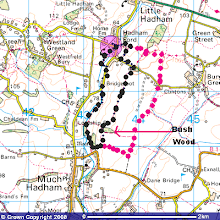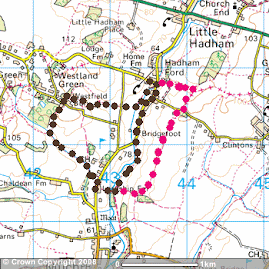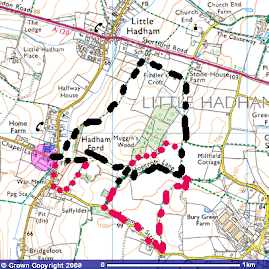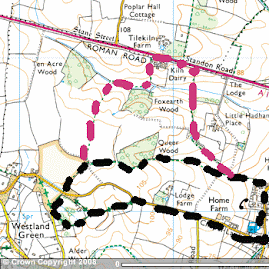Thought I would just put this out there for anyone thinking of doing a spot of autumn birding around the town. Plenty of places to visit.
Bishop's Stortford:
Castle Gardens:
A superb habitat, especially for those new to birding where they can get relatively close to the birds and develop binocular skills. Also, as there are plenty of common species, good for youngsters to begin learning their regular birds.
Resident species: Blue tit, Great tit, Long Tailed tit, Song thrush, Mistle thrush, Blackbird, Robin, Wood pigeon, Collared dove, occasional Kingfisher, Wren, Dunnock, Chaffinch, Goldfinch, Moorhen, Mallard
Winter visitors: Fieldfare, Redwing, Lesser redpoll and Siskin. For the first two, Sworder's Field is a regular haunt for them as from mid October whilst the two finch species can be found feeding in the trees overhanging the river, especially the alders with their small green cones upon which Siskins in particular feed.
Check also under the bridge by the entrance from the Causeway carpark for any overwintering Grey wagtail. These will also be present on the shingle/muddy banks and in the vegetation on the surface.
 |
| Redwing, a winter thrush with obvious white eye stripe |
River Stort: Castle Gardens to Swimming Pool
As well as those mentioned above, always a chance to add some of the larger birds on this stretch of the Stort. Jays and Magpies in the trees as well as both Great spotted and Green woodpeckers whilst on the football fields there are usually plenty of Black headed gulls, which, at this time of year, DON'T have black heads. They will be the smallest gull present and can be found in their 100's sometimes. Larger grey gulls will most likely be Herring gulls whilst the ones with darker backs will be Lesser black backed gulls. Always the chance of a Common gull showing a bright yellow bill and yellow/green legs.
Nuthatches and tree creepers are also present as are goldcrests
Overhead, Red Kites, Common buzzards and kestrels with a chance of a flyby Sparrow hawk
 |
| Kingfisher |
Swimming Pool to Bat Willow Hurst Country Park:
Continue along the River Stort seeing more of what has already been mentioned, with certainly more gulls upon the fields, especially after a match when there will be mud and soil exposed. This is the best area for Kingfishers. Keep looking ahead on branches overhanging open water. All black bill is male, red on lower mandible will be female. Often seen as no more than a flash or electric blue and orange as they whizz by In the Red White and Blue field beyond Cannons Mill Lane railway crossing always a chance of pied wagtails feeding in the grass around cattle hooves. More birds of prey overhead along with plenty of Jackdaws, Carrion crows and rooks.
By the small car park by the railway line there is a copse of trees which regularly hold tree creepers. Both Grey and Pied wagtails can be found around the Balancing Pools in the country park with the possibility of an overwintering Chiffchaff which at this time of the year, frequently associate with water as there will still be insects for them to feed upon.
 |
| Chiffchaff |
Registry Office to Twyford Lock including Rushy Mead Nature Reserve:
A good bird walk this one, offering much with plenty of mallards and a few mute swans upon the river. Tit species in the trees and bramble patches near the station and even more possible once over the road by Stanley Tees offices. Here, Magpies, Jays, corvids (crow species) and plenty of finches such as Chaffinches, Goldfinches, possible Greenfinches and the secretive Bullfinch. Linnets in their large winter flocks overhead. Coots and Moorhens especially around South Lock and the canoe club.
Rushy Mead Reserve well worth a wander around. Follow the path to a screen and viewing point which overlooks an area of cut reeds. Snipe can be seen here but will need a good eye for them as their camouflage is superb. Alder trees here hold redpolls and siskins annually, best for them on a really cold winter morning but present throughout. Listen for their thin wispy calls as they fly from tree to tree in large numbers. A good sign that they are these species is their preference for hanging from the cones and feeding upside down.
This is another good site for Goldcrests, tree creepers, nuthatches as well as the more common species associated with woodland such as woodpeckers. Every now and again there are sightings of Lesser spotted woodpecker along this stretch. These are tiny birds, no larger than a sparrow and show white and black barring on their backs as opposed to the patches upon the more common Great spotted woodpecker.
The walk concludes at the lock gates where there are often 5 - 6 Little grebe each winter, but a quick check in the adjacent car park can give great views of goldfinches feeding upon seed heads, particularly teasel if it is present.
 |
| Lesser spotted woodpecker, Twyford Locks in 2014 |
Cemetery:
Accessed either at the top of Thorley Lane next to the small Tesco or from Apton Road by the small roundabout on Scott Road.
Super little site this, with a wide range of tree species offering different species food and roosting sites. The large conifers here are particularly worth checking. Stand next to a tree trunk to blend in and just wait as Coal tits and Goldcrests flick through the branches. Watch for any moving branches and with a little patience and luck, good views will be afforded. Plenty of wrens, robins, dunnocks, more common tit species as well as Collared doves and Wood pigeons will be present. In previous winters I have encountered Siskin and Redpolls here and if we get what is known as a "Waxwing Winter" then they can often be found here. However, if this superb species does turn up in town they will certainly be mentioned on the Stortford Nature FB account very promptly, I am sure. Over the years they invariably merit a mention in the local paper, too. Waxwings migrate to the UK in huge numbers every 5 - 7 years, usually either due to a population explosion in their breeding grounds of Scandinavia or due to a failure of beech mast and berry bearing trees. These mass migrations are known as irruptions. They will almost certainly be found on berry bearing plants in the cemetery such as yew, but also go for other berry types in such birding hotspots as Tesco carparks. We are due a Waxwing Winter.
Like Castle Gardens, the birds here are more used to humans and therefore become less wary, giving good opportunities for folk relatively new to bird watching the chance to observe at relatively close quarters. Also, good for enthusiastic youngsters, too.
 |
| Waxwing, Bishop's Park, 30th October - 2nd November 2016 |
 |
| Same bird |
 |
| Always a highlight to watch these superb birds. |












































No comments:
Post a Comment